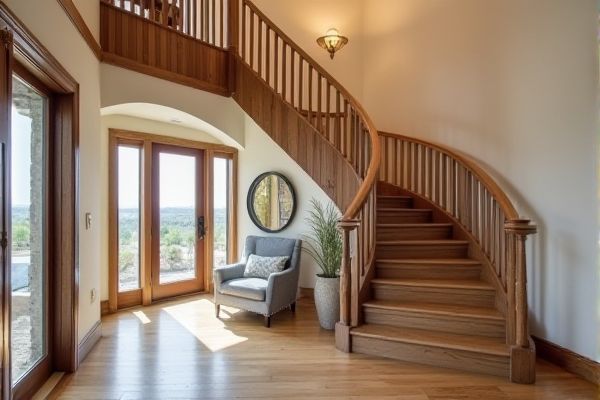
Winder staircases save space by featuring triangular steps that turn corners, while switchback staircases consist of straight flights connected by a landing, providing easier navigation and improved safety. Explore the rest of the article to determine which staircase design suits your home's layout and style best.
Table of Comparison
| Feature | Winder Staircase | Switchback Staircase |
|---|---|---|
| Design | Triangular or pie-shaped steps turning corners | 180-degree U-turn with a landing |
| Space Efficiency | More compact, saves floor space | Requires more space due to landings |
| Safety | Less safe due to uneven step shapes | Safer, uniform steps with landings |
| Comfort | Less comfortable for frequent use | More comfortable, easier to climb |
| Installation Complexity | More complex due to angled steps | Simpler construction with straight flights |
| Common Uses | Residential spaces with limited area | Commercial and residential buildings needing safety |
Introduction to Winder and Switchback Staircases
Winder staircases feature triangular or pie-shaped steps that turn corners without a landing, optimizing space in compact areas and offering a smooth, continuous upward flow. Switchback staircases consist of two parallel flights separated by a landing, allowing a 180-degree change in direction and providing a comfortable, segmented ascent. Your choice between these designs depends on spatial constraints, aesthetic preferences, and user safety requirements.
Definition and Key Features of Winder Staircases
Winder staircases are defined by their triangular or pie-shaped steps that allow the stairs to turn corners without the need for a landing, making them ideal for saving space in compact areas. Key features include continuous steps that change direction smoothly, often used in tight floor plans where a switchback staircase--with its flat landing between flights--might be too bulky. If you're looking to maximize your stairway's footprint while maintaining flow, a winder staircase offers a sleek and efficient solution.
Definition and Key Features of Switchback Staircases
Switchback staircases, also known as U-shaped staircases, consist of two parallel flights of stairs connected by a landing that reverses the direction, creating a 180-degree turn. Key features include efficient use of vertical space, increased safety with landings for rest, and suitability for narrow or compact floor plans. These staircases provide clear separation between ascending and descending paths, making them ideal for high-traffic areas in residential and commercial buildings.
Space Efficiency: Winder vs. Switchback Staircases
Winder staircases maximize space efficiency by incorporating triangular steps that seamlessly navigate tight corners, making them ideal for compact areas where floor space is limited. Switchback staircases, also known as U-shaped stairs, require a landing and two straight flights, occupying more floor area but providing safer, more gradual ascents ideal for larger spaces. Choosing between the two depends on balancing available space constraints with functional safety requirements.
Safety Considerations for Each Staircase Type
Winder staircases feature triangular steps that can create narrow treads, increasing the risk of missteps and requiring careful attention to handrail placement to enhance safety. Switchback staircases offer straight flight sections with landings, providing stable resting points and reducing fall hazards through consistent tread dimensions. Your choice should weigh spatial constraints against user mobility needs, as switchback designs generally offer safer navigation for children and elderly individuals.
Aesthetic Appeal and Design Flexibility
Winder staircases offer a visually dynamic alternative with their triangular steps creating a flowing, curved appearance that enhances aesthetic appeal in compact spaces. Switchback staircases provide greater design flexibility through their straight flights and 180-degree turns, accommodating various floor plans and allowing for the integration of landings that can serve as functional or decorative elements. Both designs maximize spatial efficiency while contributing distinct architectural character to interiors.
Construction Complexity and Cost Comparison
Winder staircases feature triangular steps that turn corners without landings, requiring precise craftsmanship and complex framing, which typically increases labor costs. Switchback staircases use straight flights connected by a landing, simplifying construction with standardized measurements and reduced framing complexity, resulting in lower material and labor expenses. Budget-conscious projects often favor switchback stairs due to their straightforward assembly and cost-efficiency compared to the intricate design and higher installation costs of winder stairs.
Suitable Applications in Residential and Commercial Settings
Winder staircases are ideal for residential settings where space is limited, such as small homes or apartments, due to their compact, angular design that fits neatly into corners. Switchback staircases, featuring straight flights with landings, are better suited for commercial buildings and larger homes where safety and ease of movement are priorities, as they provide clear resting points and accommodate higher foot traffic. Both stair types offer efficient vertical circulation, but selection depends on the specific spatial constraints and usage requirements of the building environment.
Accessibility and Building Code Compliance
Winder staircases feature triangular steps that save space but can pose accessibility challenges due to uneven tread widths, often requiring careful consideration to meet building code requirements for safety and ease of use. Switchback staircases, with their straight flights connected by landings, offer improved accessibility and better compliance with building codes, providing uniform step dimensions and rest areas that accommodate users with mobility limitations. Your choice between the two should prioritize adherence to local building codes and the specific accessibility needs of all potential users.
Conclusion: Choosing the Right Staircase for Your Needs
Winder staircases save space by incorporating angled steps that change direction without a landing, making them ideal for compact areas. Switchback staircases use straight runs connected by landings, offering increased safety and ease of use in larger spaces or high-traffic environments. Selecting between the two depends on your available space, safety priorities, and architectural style preferences.
 homyna.com
homyna.com